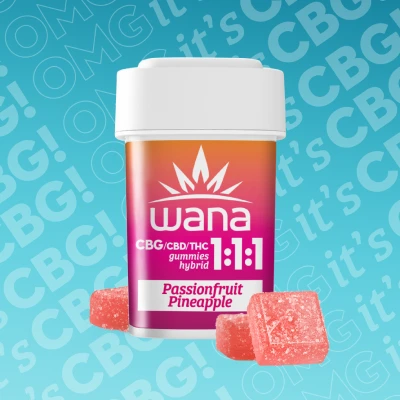Danksgiving Recipes
Back Danksgiving Recipes Cannabis and Thanksgiving have always gone hand in hand. This year our friends at Ripple bring them both together with some great
Looks like you have not added anything to your cart, go ahead and explore our top categories.
Get rewards, free stuff, and exclusive deals when you join our loyalty program.

Guest post from Wana Brands.
You’ve heard of THC and CBD. But you may be less familiar with another up-and-coming cannabinoid, cannabigerol (or CBG). Since CBG seems to be a rising star in the weed world, it’s worth learning how it works. So, here’s a simple guide to CBG and its various health benefits.
What is CBG?
On a scientific level, CBG is one of more than 100 rare cannabinoids in the cannabis plant. It’s sometimes called “the mother” of all cannabinoids because its acidic form converts to THC and CBG as the plant ages.
What does CBG do?
Consumed on its own, CBG won’t get you stoned. But early research suggests a host of CBG benefits, including relief from pain and inflammation, anti-anxiety effects, and some anti-bacterial properties.1,2 There’s also compelling evidence that CBG elevates your body’s levels of GABA, a calming neurotransmitter associated with feelings of relaxation and contentment.3
CBD vs. CBG
CBD and CBG are non-intoxicating (meaning they won’t get you high). They’re also associated with some of the most sought-after benefits of marijuana – including reduced inflammation, relief from stress, better mood, and more.1
Unfortunately, there needs to be more research on the differences between the two. As far as we know now, there are only a couple of big ones:
That said, it’s not fair to pit CBD and CBG against each other. Instead, we should ask, “How do they work together?”
CBG and Your Endocannabinoid System
The reason CBG, CBD, and even THC can make a great power throuple comes down to what’s known as your endocannabinoid system (ECS). The endocannabinoid system is a complicated network of receptors and transmitters that helps regulate appetite, mood, sleep cycles, and much more.4,5 Cannabinoids interact with these receptors to send signals to your brain. So, for example, “It’s time for a snack,” or, “Let’s take a nap,” or, “Yes, we’re aware we worked out too hard; let’s ease up on the back workout.”
Different cannabinoids interact with various receptors in different ways. For example, if your back aches, THC might stimulate a part of your ECS called the CB1 receptor, helping the muscles relax. Meanwhile, CBD and CBG interact with another group of receptors (known as CB2), which are believed to regulate inflammation. In other words, you’re attacking two sides of the problem at once.
Where Can You Find CBG Products?
Check your labels and ask your budtenders for help. And after years of R&D, Wana Brands has recently launched not one, not two, but three CBG-powered gummies.
The first two, which you may already be familiar with, are Wana’s best-selling Fast and Stay Asleep Optimals formulations. Fast Asleep is powered by fast-acting technology, which could make you sleepy in 5-15 minutes, while Stay Asleep is formulated to keep you snoozing all night long.
More recently, Wana launched a new addition to an existing lineup of CBD/THC ratio products: 1:1:1 Passionfruit Pineapple Gummies, which contain 10mg each of CBG, CBD, and THC. While CBD and CBG have much potential for aiding with things like sports recovery and stress relief, early feedback from consumers and budtenders suggests that Wana’s addition of THC also creates a relaxing but-inspiring high that’s good for getting creative or spending time with friends. These fruity CBG gummies are currently on sale in Colorado, with plans to expand to other states before the end of 2023.
A version of this blog post first appeared on wanabrands.com.
Citations
Back Danksgiving Recipes Cannabis and Thanksgiving have always gone hand in hand. This year our friends at Ripple bring them both together with some great
Back Playing With Ratios: How to Enhance Your Edible Experience Disclaimer: Always know your dosing limits for the best cannabis experience. When in doubt, start
Back Revolutionary Gummies: Redefining Edibles If you’re an edibles-loving Coloradan, you’re probably familiar with Wana Gummies The Boulder-based company has spent the last 11+ years
Edibles | Marijuana, THC